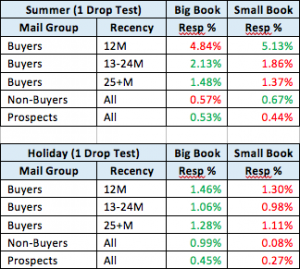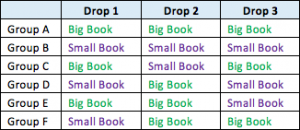Are you getting pressure from the top to reduce catalog spend? Are you having to produce the same amount of productivity with a smaller a catalog budget? Getting ready for the 2018 season, I’ve been getting many questions from clients regarding how book size affects catalog performance. Over the years, we have observed many tests where clients have moved to letter-rate-qualifying digest or slim-jim sizes, trimmed to a smaller book size, or reduced page counts. Providing that there is productive product to present, these tests have shown that less paper and fewer product presentations result in reduced response, and rarely yield a higher ROI. In general, our rule of thumb is that a 10% reduction in paper and product reduces response by 5%.
However, as with any rule, there are exceptions, especially regarding book size. Below is an example of a recent mailing test that yielded very different results in the Summer and Holiday mailings:

In the first table, you can see that across both the house file and prospects, the results between the big book and the small book were not significantly different, with 12-month buyers actually responding better to the smaller book. The small book clearly had the better ROI. In the second table, the larger book generated a higher response rate for all segments including prospects. So, why did the Summer and Holiday results differ so significantly? In this case, we believe that in the core season (Summer), perhaps the 0-12M buyers would have made a purchase anyway, so a smaller book was enough for them. But when it comes to a slower time of year, a bigger book with more product may be required across all segments (house and prospects) to generate a higher response rate.
Since both of the tests above were executed as one-off tests, we’d recommend stretching the test across an entire season, ensuring that we create proper test/control groups, and keep them static throughout the entire season. If you’re considering reducing or increasing the size of your catalog across all seasons, below is an example of a testing grid that you can set across the entire mailfile to measure the response differential for Buyers vs. Non-Buyers/Prospects.
If you intend to reduce catalog size as a long term strategy, there multiple things you can do to help keep performance up:

Look at the square inch analysis from the prior year and remove any unproductive pages or items. Make sure the smaller book is jam-packed with highly productive pages and products.
Make sure your digital programs are firing on all cylinders. Invest a little more in your digital acquisition efforts and make sure your active search terms are working. This is especially important for prospect records that aren’t familiar with your brand. If you’re sending a smaller book to prospects, you want to make it easy for those prospects to find you on the web.
Be social! Help your prospecting performance by supplementing with the Facebook Sync and Send program. This will serve up Facebook ads to your prospective customers by getting in front of them as the book goes in-home. See Michelle Houston’s article for more information on how to integrate Facebook into your marketing plans.
However, as in the example above, it may be more productive to consider using a mix of big books and smaller page counts or format. Think through the purpose of the catalog. The smaller book may be just as effective in presenting promotional offers. The larger catalog may be necessary to represent the brand and adequate product. We have several clients that have found a simple low-cost postcard is adequate to drive customers to their website and stores when presenting a major sale. By planning an annual contact strategy that contains a variety of presentations, you may be able to achieve the same savings that would be achieved by reducing the size of all of your catalogs throughout the year.
I know I covered a lot here, but changing the size of your catalogs is a complex issue and can have major impact on the performance of your business. Whatever you do, test any major changes you are considering. And consider any changes you make in the context of the purpose of each catalog.
If you have any questions or concerns, please feel free to contact me at bslattery@cohereone.com.
